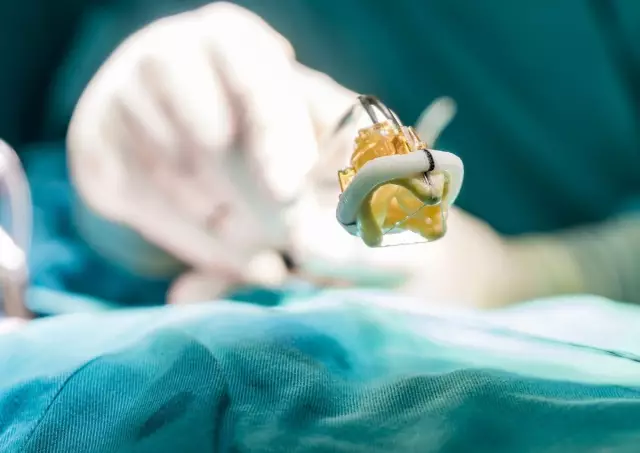- Author Rachel Wainwright [email protected].
- Public 2023-12-15 07:39.
- Last modified 2025-11-02 20:14.
Coronary insufficiency
The content of the article:
- Causes
- Kinds
- Symptoms of coronary insufficiency
- Diagnostics
- Coronary insufficiency treatment
- Prevention
- Potential consequences and complications
Coronary insufficiency is a pathological condition that develops as a result of complete or partial cessation of blood flow through the coronary (coronary) arteries, which leads to an inadequate supply of nutrients and oxygen to the myocardial cells.

Source: vredena.ru
Coronary insufficiency underlies the pathological mechanism of the development of coronary heart disease, but it can also form against the background of some other pathologies caused by damage to the coronary arteries.
For coronary insufficiency, local myocardial ischemia is characteristic, while general hypoxia is caused by pathologies of the structure of hemoglobin molecules, respiratory failure, severe anemia, and not by a vascular factor.
Causes
The development of coronary insufficiency is caused by impaired blood flow through the coronary arteries, caused by various pathological factors, which include:
- occlusion of the lumen of the coronary arteries by a thrombus or atherosclerotic plaque;
- spasm of the coronary arteries;
- subendothelial hemorrhage;
- narrowing of the lumen of arteries as a result of compression from the outside by a foreign body, tumor or adhesions;
- productive inflammation, leading to the proliferation of connective tissue.
A very rare cause of coronary insufficiency is the presence of a shunt between the arteries of the lungs and the arteries of the heart, through which blood is released from the coronary arteries into the pool of the pulmonary arteries, since the pressure in them is lower.
Factors predisposing to coronary insufficiency are:
- coronarite;
- congenital and acquired heart defects;
- anaphylactic shock;
- pulmonary stenosis;
- aortic aneurysm;
- atherosclerosis of the coronary vessels;
- diabetes.
Kinds
Depending on the duration of the course and the severity of clinical symptoms, coronary insufficiency is divided into three types:
- acute coronary insufficiency - occurs as a result of a sudden cessation of blood flow through one of the branches of the coronary artery, for example, when it is blocked by thrombotic masses. Often leads to the development of myocardial infarction, can cause sudden death of the patient;
- chronic coronary insufficiency - its development is caused by a slowly progressive disturbance of blood flow through the coronary artery, for example, associated with the growth of atherosclerotic plaque. Clinically manifested by periodic heart attacks, proceeding as angina pectoris;
- relative coronary insufficiency - develops as a result of an increase in the heart (hypertrophy with aortic defect, arterial hypertension) and lagging behind this process of the coronary vessels.
According to the severity of clinical manifestations, the following forms of chronic coronary insufficiency are distinguished:
- Lightweight. Attacks of angina pectoris rarely occur, they are caused by excessive mental experiences or physical exertion.
- Medium severity. A heart attack is triggered by external influences, most often by increased physical activity, such as climbing stairs, jogging, or walking very fast. On the electrocardiogram, most patients show a characteristic change in the teeth, which are especially pronounced in persons who have had a previous myocardial infarction and suffer from cardiosclerosis. A painful attack can be combined with heart rhythm disturbances.
- Heavy. An attack of angina pectoris is provoked even by minor physical exertion or psychoemotional experiences. It can also occur during rest, including during a night's sleep. Pains are often combined with the appearance of cardiac asthma. The examination reveals severe cardiosclerosis, signs of chronic heart failure.
There are also reversible and irreversible coronary insufficiency.
Symptoms of coronary insufficiency
Acute coronary insufficiency develops due to a sharp cessation of blood flow through one of the branches of the coronary artery, as a result of which severe hypoxia occurs in the local part of the myocardium and metabolic processes are significantly disturbed. Clinically, the pathology is manifested by an attack of angina pectoris or its equivalents, for example, paroxysmal dyspnea, myocardial infarction.

Source: okeydoc.ru
Symptoms of acute coronary insufficiency:
- pain in the projection of the heart, which can radiate to the left arm, shoulder blade, neck, upper abdomen;
- feeling short of breath;
- anxiety, fear of death;
- pallor of the skin.
Chronic coronary insufficiency is long-term, slowly progressing. Initially, it manifests itself as attacks of angina pectoris arising under the influence of significant loads, i.e. episodes of acute coronary insufficiency. A progressive decrease in coronary blood flow leads to an increase in these attacks, contributes to the formation of cardiosclerosis, ischemic myocardial dystrophy.
Diagnostics
The most important role in the diagnosis of coronary insufficiency is played by electrocardiography performed under conditions of dosed physical activity. A characteristic ECG sign of coronary insufficiency is the depression of the ST segment that occurs during maximum physical activity or 2-5 minutes after it. As an indirect sign of coronary insufficiency, the arrhythmia arising during the exercise test should also be regarded.
In order to assess the condition of the coronary arteries, to accurately identify the site of occlusive or stenotic lesions, coronary angiography is performed - a method of X-ray diagnostics using a contrast agent.
Laboratory diagnostics of coronary insufficiency includes determination of the concentration of electrolytes, glucose, creatine kinase, lactate dehydrogenase, triglycerides, low and high density lipoproteins, ALT and AST, total cholesterol in the blood serum. Particular diagnostic value is assigned to the determination of tropes I and T, markers of hypoxic myocardial damage. Their detection is a sign of the occurred infarction or myocardial microinfarction.
Differential diagnosis is required with a number of other pathologies, accompanied by the appearance of pain in the chest or retrosternal region. These include:
- esophageal spasm;
- esophagitis;
- gastritis;
- cholecystitis;
- stomach cancer;
- peptic ulcer of the stomach and duodenum;
- pericarditis;
- chest osteochondrosis;
- pulmonary embolism;
- aortic dissection;
- pneumothorax;
- pulmonary hypertension;
- osteoarthritis of the shoulder joints;
- damage to the roots of the spinal cord;
- psychological reasons (cardioneurosis, increased suspiciousness, anxiety).
Coronary insufficiency treatment
Complex therapy of coronary insufficiency includes:
- General measures aimed at eliminating risk factors for insufficiency of coronary circulation. These include: dosed physical activity, correct alternation of work and rest regimes, good sleep lasting at least 8 hours, quitting smoking and alcohol abuse, treatment of concomitant diseases, normalization of body weight, spa treatment.
- Antianginal and antiarrhythmic drug therapy aimed at relieving angina attacks and preventing their recurrence, treating conduction disorders and arrhythmias.
- Other types of drug therapy. Depending on the indications, hypolipidemic agents, anticoagulants, etc. are prescribed.
Therapy of chronic coronary insufficiency is carried out with drugs of the following groups:
- vasodilators;
- drugs acting on the adrenergic innervation of the myocardium;
- anti-bradykinin drugs;
- drugs of other groups (diuretics, antiarrhythmic, antihypertensive, etc.).
With resistance to the ongoing conservative therapy, surgical treatment is indicated, the purpose of which is to restore blood supply at the local site of myocardial ischemia (revascularization).
The most commonly used is coronary artery bypass grafting (CABG). The essence lies in the creation of an autovenous anastomosis between the affected coronary artery and the aorta below the site of occlusion or stenosis that prevents normal blood flow. Thanks to the anastomosis, the blood flows around the existing obstacle, and the blood supply to the myocardium in the ischemic zone is restored. Coronary artery bypass grafting can be performed on a beating heart ("beating heart CABG") or by cardiopulmonary bypass.

Source: simptomer.ru
One of the options for the surgical treatment of coronary insufficiency is a minimally invasive operation - percutaneous transluminal coronary angioplasty (PTCA). During PTCA, the stenotic coronary artery is expanded with an inflating balloon, after which a stent is installed in it, which acts as a frame, which provides sufficient vessel lumen for normal blood flow and prevents stenosis from recurring.
Prevention
Prevention of coronary insufficiency is based on the exclusion of factors contributing to its occurrence and progression. Recommended:
- quitting smoking and alcohol abuse;
- exclusion of psycho-emotional overload;
- physical education;
- healthy eating;
- blood pressure control;
- maintaining optimal body weight.
Potential consequences and complications
The main complications of coronary insufficiency are:
- myocardial infarction;
- blockade of the pathways;
- arrhythmias.
The prognosis depends on the number of affected coronary arteries and the state of the left ventricular myocardium. Diabetes mellitus, severe lipid metabolism disorders, and arterial hypertension have an adverse effect on the course of chronic coronary insufficiency.
YouTube video related to the article:

Elena Minkina Doctor anesthesiologist-resuscitator About the author
Education: graduated from the Tashkent State Medical Institute, specializing in general medicine in 1991. Repeatedly passed refresher courses.
Work experience: anesthesiologist-resuscitator of the city maternity complex, resuscitator of the hemodialysis department.
The information is generalized and provided for informational purposes only. At the first sign of illness, see your doctor. Self-medication is hazardous to health!






